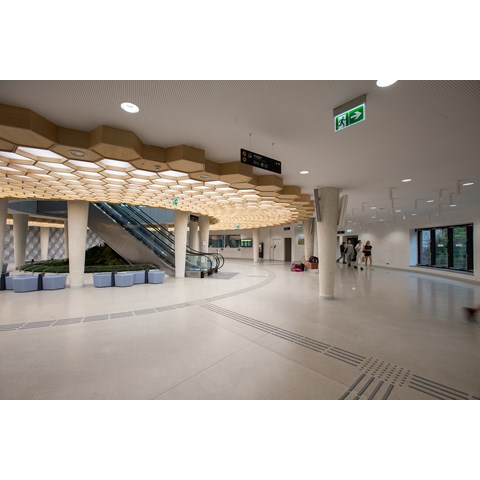When preparing an emergency lighting layer for an open area, it’s a good idea to find the answer to one question first – what function will this room fulfil in its final form? Two scenarios are possible here: it will either be a space with a known and well-defined function, or its function will change over time. These scenarios are crucial for further lighting design work.
What’s classified as an open area?
From the perspective of the applicable emergency lighting standard, an open area is defined as a space with a floor area exceeding 60 m2. When designing evacuation lighting for such spaces, it’s necessary to ensure the proper illumination during an emergency for all areas unoccupied by machinery and furniture where any risk factors for people’s health or lives may occur. The standard also describes what forms of security measures should be introduced in the design, and when. Those measures are also used for areas smaller than 60 m2 if hazardous situations to people’s lives and health may occur in such spaces. It is worth remembering that when performing illuminance calculations, the measured area should be smaller than the actual area of the room. A margin of 0.5 m on the perimeter of the room should be excluded from the calculation as it is irrelevant from the point of view of ensuring safety.
Emergency planning for diverse spaces
When preparing the emergency lighting design for open areas, their target functionality should be defined in order to correctly estimate the probability of the occurrence of threatening situations. If the room’s function will change during its use (e.g. when it’s a part of hotel infrastructure and will sometimes be used as a restaurant, or as a conference room, or as a dance hall), it’s important to take that into account during the design process. For the purposes of emergency lighting design, it’s smart to prepare for the worst-case scenario that could potentially occur in this space.
Adjusting the number of luminaires depending on needs
During the process of placing and arranging the luminaires and setting up the lighting control, all possible assembly scenarios and situations should be taken into account. If the space in question will additionally be divided in some way, for example with partition walls, and the escape routes or the layout of the open areas will change, this should also be included in the emergency lighting design.
This may make it necessary to increase the number of emergency lighting luminaires in order to properly illuminate the open area, and additional escape route lighting and safety signs may also be required.
EU guidelines require proper evacuation conditions for all occupied workspaces
Important emergency lighting design principles to remember about for open areas:
- open area (anti-panic) lighting
for areas without machines or furniture but occupied by people, in spaces where risk factors may occur, like large accumulations of people or if the room area exceeds 60 m2 - escape route lighting
if the escape route leads through the room from other rooms - safety sign lighting
that indicates the course of the escape route and the way to accessing it - lighting for points of emphasis
such as first aid kits and firefighting equipment
Emergency lighting requirements:
| Type of emergency lighting task / activity area |
Illuminance level (Emin) / Luminance level (Lmin) |
Diversity ratio (Ud) |
Area |
Duration |
Time until 50% / 100% illuminance is achieved |
| Open area lighting | 0.5 lx | 1:40 | Floor area excluding a 0.5 m margin |
1 h | 5 s / 60 s |
| Escape route lighting | 1 lx | 1:40 | 2 m on the floor | 1 h | 5 s / 60 s |
| Exit signs on the escape route | 2 cd/m2 | 10:1 | Safety sign | 1 h | 5 s / 60 s |
| Lighting of points of emphasis | 5 lx | Not applicable | Point of emphasis | 1 h | 5 s / 60 s |
,(0.5,0.3266979,1,0.6533958)&format=jpg)